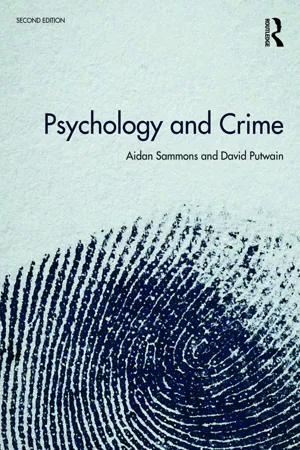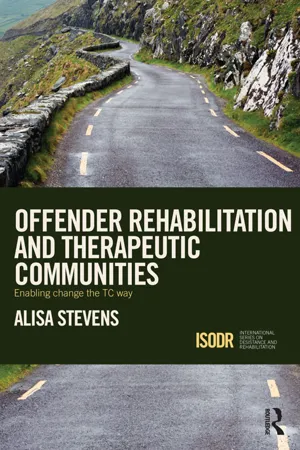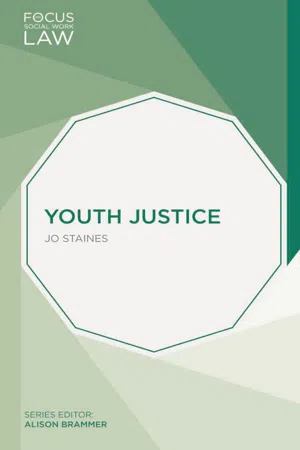Psychology
Community Sentencing
Community sentencing is a form of punishment that involves offenders serving their sentence within the community rather than in prison. It aims to rehabilitate the individual by providing access to support services and programs while maintaining a level of accountability. This approach is often used for non-violent offenders and can include measures such as community service, electronic monitoring, or treatment programs.
Written by Perlego with AI-assistance
7 Key excerpts on "Community Sentencing"
Learn about this page
Index pages curate the most relevant extracts from our library of academic textbooks. They’ve been created using an in-house natural language model (NLM), each adding context and meaning to key research topics.
- eBook - ePub
- Dr Mike Stephens, Mike Stephens, Pete Alcock, Professor Peter Alcock (S Ed), Pete Alcock, Professor Peter Alcock (S Ed)(Authors)
- 2014(Publication Date)
- Routledge(Publisher)
Once, the major role of community sentences was to reduce the prison population, for these penalties were seen as alternatives to imprisonment. Now, they are sentences in their own right. Moreover, probation officers are today more closely tied to the courts, in the sense that as officers of the court their preparation of pre-sentence reports must help the sentencer to assess the risk of re-offending. Currently, community penalties reflect a greater concern for the interests of the public than the needs of the offender. As such, they have moved from being a treatment-oriented alternative to custody to being a more punishment-oriented sanction for crimes of intermediary seriousness with a stress on just deserts and denunciation (Davies et al. 1998). It is not easy to evaluate the worth of community sentences, not least because they appear to have several aims. If the aim of such sentences is to provide alternatives to custody then they have largely failed since the prison population continues to increase. On the whole, in terms of recidivism rates, community sentences do no better nor worse than custody. If the aim is to make available a cheaper form of penalty for offenders then, compared with the cost of custody, community sentences enjoy a great advantage. Finally, when considering the cost-effectiveness of community sentences versus custody, one should not forget that community penalties are in general less degrading and dehumanizing than prison and do not exact such a toll in the numbers of suicides and self-injury cases. In a saner world, we would not be having to justify the punitiveness of community sentences, but the punitiveness of prison. However one evaluates them, community-based penalties clearly have a future. The questions that may be asked of them are likely to be two-fold - Peter Joyce, Wendy Laverick(Authors)
- 2013(Publication Date)
- Teach Yourself(Publisher)
Punishment in the community
Those who break the law will (if caught) be punished for their actions. However, there are a wide range of options that can be used as responses to crime. In particular, there exists a distinction between serious offences that require the offender to be removed from society and placed in prison and less serious crimes for which the lawbreaker can serve a penalty while remaining a member of his or her community. This chapter examines penalties that are imposed on offenders which are served in the community as opposed to custodial regimes. It examines the nature of community-based sentences and the issues that are raised by the use of these as a response to crime.Community sentences
Key ideaSentences served in the community may impose a wide range of demands upon an offender. These may include performing unpaid work within the community or taking part in treatment programmes.There are various ways whereby those who commit criminal offences can be punished for their crimes. For example, an offender may be fined for his or her offence. This penalty was traditionally a sentence of a court, but in England and Wales low-level crime and disorder may be punished by an on-the-spot fine handed out by a police officer. This procedure is often referred to as summary justice.In this chapter, however, we will focus on sentences which are served in the community but which have an element of supervision attached to them. In England and Wales, this supervision was traditionally provided by the Probation Service, although in recent years some aspects of this work have been carried out by private sector companies. Electronic monitoring (or tagging) is also used to monitor an offender’s compliance with the terms of a community sentence.In England and Wales, community-based sentences for adult offenders that contain an element of supervision are governed by the 2003 Criminal Justice Act. This legislation replaced earlier forms of community-based sentences (such as probation orders and community service orders) with a new penalty termed a community order. This comprises a wide range of components (which are termed ‘requirements’), consisting of:- eBook - ePub
Psychology and Crime
2nd edition
- Aidan Sammons, David Putwain(Authors)
- 2018(Publication Date)
- Routledge(Publisher)
The judicial system responds to offending with a range of sanctions including both custodial and non-custodial sentences. Imprisonment is the most serious sanction available in most Western democracies but its use varies widely. In the UK and US, there was a substantial growth in imprisonment between the 1940s and the present day. Prison serves a number of functions including retribution, incapacitation, deterrence and reform of the offender. Although it is painful for the offender in a number of ways and may affect her physical, psychological and social wellbeing, there is little evidence to suggest that it reforms criminals and some that suggests it makes offending worse. However, it does incapacitate offenders for the duration of their sentence and is a necessary measure in the case of those who pose a significant risk to society. Imprisonment is comparatively costly and there are economic arguments for avoiding it in favour of non-custodial sentences when the risk to the public is low. Non-custodial sentences include fines and community sentences. Fines have advantages in that they do not disrupt the offender’s life in the same way as prison and they may generate revenue for the authorities. The evidence for their effectiveness is not strong, although they do have a deterrent effect on some offences. Community sentences involve releasing an offender into society but imposing requirements (e.g. community service) or restrictions (e.g. a curfew) on her, under threat of more serious sanctions. Evidence suggests that those who serve community sentences have a lower recidivism rate than those who are imprisoned and there are substantial monetary savings. Restorative justice involves offenders, victims and other stakeholders voluntarily devising ways for offenders to repair the harm they have caused. It appears to produce better outcomes than conventional justice both in terms of recidivism and victim satisfaction. However, much of the evidence in the area of non-custodial sentencing is affected by selection bias, as only in a few studies are offenders randomly assigned to different punishments. Consequently, the evidence base exaggerates the difference in effectiveness between prison and the alternatives. - eBook - ePub
- Edward J. Latessa, Brian Lovins(Authors)
- 2019(Publication Date)
- Routledge(Publisher)
Some offenders are placed on community supervision to punish them and to deter them, it is hoped, from future crime by holding a prison sentence over their heads. Sanctions such as electronic monitoring may be used to try to “incapacitate” them by restricting where and when they can go out. The probationer may also be required to perform community service or make some restitution to the victim. Finally, the court may require the offender to attend programs and services designed to help them change their behavior and learn new skills to avoid future risky situations. As you learn more about community corrections, you will see all of these purposes play out as part of the sanctions that are imposed. SENTENCING OPTIONS In the plea-bargaining process, the defense counsel may negotiate the sentence outcome to avoid incarceration of the accused. Thus, the decision to incarcerate may, in part, depend on the outcome of negotiated justice. The two major incarceration outcomes are imprisonment in a penal facility or in a jail. The major alternative to incarceration is probation and other intermediate punishments such as weekend confinement, house arrest, residential treatment (such as a halfway house or community correctional center), electronic monitoring, fines, restitution or work centers, intensive supervised probation, and other alternatives. If the decision is made to place the person on probation or other intermediate punishment, usually as a condition of probation, the offender is typically supervised by an officer of the local or state probation department. Conditional freedom under probation requires the probationer to meet certain conditions of behavior (see Chapter 4) - eBook - ePub
- Francis Pakes, Suzanne Pakes(Authors)
- 2012(Publication Date)
- Willan(Publisher)
Chapter 5
Sentencing and punishment
In Chapter 1 we saw that there are over 10 million crimes committed in England and Wales each year. Currently the prison system holds just over 80,000 inmates. From comparing those two statistics one conclusion can be drawn: most offenders are not in prison. We have seen that most crimes are never prosecuted. But in addition, community sentences and fines are imposed much more frequently than prison sentences.In this chapter we shall first examine the process of sentencing. After that we shall look at the implementation of sentences which we call punishment. Punishment is an emotive term. It implies the infliction of harm. Indeed, that is part of the reason why punishment is imposed. But it not the only or even the prevailing reason. Other factors that come into play include rehabilitation, which is based on the idea that offenders can be changed, and that those changes will reduce the chance of reoffending. A further consideration is public protection. When we take an offender out of the community, that community will no longer be at risk of the offending behaviour of that individual.Sentencing
Most of the time, a sentence is imposed with several reasons in mind. A judge might send a violent offender to prison because that sentence corresponds to a tariff. That means that a prison sentence is the ‘going rate’ for that offence. In addition, a judge might decide that whilst in prison, the offender should undertake either counselling or training. Such skills might decrease the likelihood of reoffending. Finally, a judge might decide that the needs of the victim are best served with a particular sentence.Apart from prison a judge has a range of sentencing options. We make a distinction between three types of sentences. The first is prison, or detention, often called custodial sentences. The second comprises community sentences which most of the time are community orders. They can involve a variety of activities. One of these activities is unpaid work. In 2007 there were about 55,000 instances of unpaid work community orders completed. Other community orders can involve training, taking part in so-called accredited programmes designed to reduce reoffending. They can also involve mental health, alcohol or drugs treatment. Much punishment, therefore, is in fact community based (Ministry of Justice 2008). Finally, the sentence in fact most often handed out is the fine (half of these are for motoring offences). See Table 5.1 - eBook - ePub
Offender Rehabilitation and Therapeutic Communities
Enabling Change the TC way
- Alisa Stevens(Author)
- 2012(Publication Date)
- Routledge(Publisher)
Introduction Offender rehabilitation and therapeutic communitiesHas prison ever felt like rehabilitation to you before?Please! Let me tell you, when I first came away, a prison would have two or maybe three psychologists and just look at how many they have now – and they’ve got to do something to justify their wage packets, haven’t they? Psychologists aren’t about helping people to change; they only care about risk assessment. TCs are about change – really helping people to change. You think nodding your head through one of them courses is going to change you? No, if you want to change, you’ve got to come somewhere like here.(Ross, GTC)After a long and chequered history, and some confusion about what it encompasses and entails, offender rehabilitation is back in fashion. The moral conviction that even people who have committed the most serious of crimes can, and do, ‘change for the better’ (Robinson and Crow 2009:3, emphasis preserved) has found empirical validation in criminological studies of desistance – the ‘giving up’ of crime – and in a body of forensic psychological research into correctional interventions.When offenders in prison and in the community, and the correctional staff tasked with working with them, talk about rehabilitation, they are generally referring not just to ‘going straight’ but the ways in which that notoriously tricky aspiration is to be achieved. Chief amongst the proposed methods in contemporary corrections is the provision of a suite of structured, cognitive-behavioural, group-work based offending behaviour programmes (OBPs). These programmes, which may address general criminal behaviour, substance misuse, or violent and sexually violent offending, derive from a series of Canadian and North American meta-analytic (statistically aggregated) studies which identified key variables associated with the reduction or elimination of criminal recidivism. The resulting literature, collectively known as ‘what works’, rescued rehabilitation, as a legitimate and feasible function of punishment, from the pessimism of the ‘nothing works’ era, unwittingly unleashed by the unfortunate Martinson (1974); provided a coherent meta-theoretical framework by which to understand ‘the psychology of criminal conduct’ (Andrews and Bonta 1994) and to devise and conduct rehabilitative work with offenders in accordance with principles of ‘human service’ (Andrews 1995) and ‘effective intervention’ (McGuire 1995, 2002); and produced some encouraging – though also some unsupportive or ambiguous – evaluations of the ability of OBPs to reduce reconviction moderately (for meta-analytic reviews and discussions of key findings, see Andrews et al. 1990; Lipsey 1992; Lösel 1995; Redondo et al - eBook - ePub
- Jo Staines(Author)
- 2015(Publication Date)
- Bloomsbury Academic(Publisher)
4
COMMUNITY SENTENCES
AT A GLANCE THIS CHAPTER COVERS:♦ the scaled approach and sentencing ♦ restorative justice ♦ community sentences ♦ additional sentences and arrangements ♦ enforcement and breach of ordersThis chapter considers the community sentences available for children and young people convicted of a criminal offence in either the Youth Court or the Crown Court. Custodial sentences for more serious and/or more persistent offenders are discussed in Chapter 5 . The purpose of sentencing is set out in the CJIA 2008: courts must have regard to the principal aim of the youth justice system, which is to prevent offending and reoffending (s. 9(2)(a)) (see Introduction). Courts must also have regard to the welfare of the offenders in accordance with s. 44 CYPA 1933 and, in addition, should take account of the following purposes of sentencing (s. 9(3)):• the punishment of offenders; • the reform and rehabilitation of offenders; • the protection of the public; and • the making of reparation by offenders to persons affected by their offences.The Supreme Court has commented, in relation to children and young people, that a key aim ‘of any sentence imposed should be to promote the process of maturation, the development of a sense of responsibility, and the growth of a healthy adult personality and identity’ (R v Secretary of State, ex parte Maria Smith






